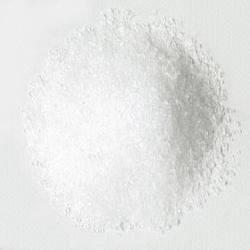Related compounds Molar mass 102.475 g/mol Boiling point 1,390 °C | Formula RbOH Melting point 301 °C Density 3.2 g/cm³ | |
 | ||
Appearance grayish-white solid, hygroscopic | ||
Rubidium hydroxide (+1) (RbOH) is a strong basic chemical and alkali that is formed by one rubidium ion and one hydroxide ion.
Contents
Rubidium hydroxide does not appear in nature. However it can be obtained by synthesis from rubidium oxide. In addition, rubidium hydroxide is commercially available in form of an aqueous solution from a few suppliers.
Rubidium hydroxide is highly corrosive, therefore suitable protective clothing, gloves and eye-face protection are required when handling this material.
Synthesis
Rubidium hydroxide can be synthesized from rubidium oxide by dissolving the oxide into water:
Rb2O (s) + H2O (l) → 2 RbOH (aq)Rubidium hydroxide is also commercially available from a certain number of chemical suppliers in form of 50% or 99% aqueous solution at multiples of 5 g.
Uses
Rubidium hydroxide is rarely used in industrial processes because potassium hydroxide and sodium hydroxide can perform nearly all the industrial functions of rubidium hydroxide in a less violent and hence safer way.
Rubidium hydroxide is used in scientific research. It is often used sparingly to prevent waste of the expensive element rubidium. For example, it is used to give fireworks a violet color in place of pure rubidium.
Despite the fact that rubidium hydroxide is rarely used in normal industrial processes, it is notable that the synthesis of nearly all rubidium compounds involves rubidium hydroxide as an intermediate. Natural rubidium oxide is added to water, and the resulting reaction forms soluble rubidium hydroxide as a product.
Hazard prevention
Rubidium hydroxide is a corrosive compound that causes immediate burns to the skin on contact. Ultimate care must be carried out when handling this chemical.
In the laboratory, protective clothing, gloves, and eye-face protection made from alkali-resistant materials are to be worn to prevent injury caused by accidental leakage of rubidium hydroxide onto human skin.
Dilution of this strong alkali must be done by adding the chemical slowly into the beaker of water.
In addition, chemical experiments on this compound must be performed with caution to prevent the great amount of heat released in an exothermic reaction from causing the solution to boil-over or damage the vessel.
